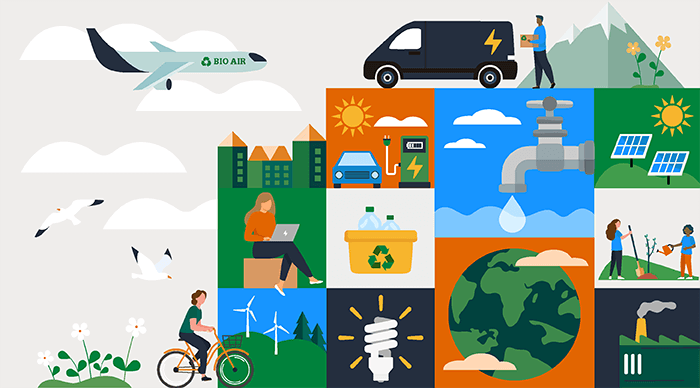
Gone are the days when people engaged in sustainability were labeled tree-huggers, or just plain weird. Finally, it has become the mainstream, and that is really gratifying. These days, I am a specialist in cataract and oculoplastic surgery based in Cardiff, UK, but back when I was a student, I was chaining myself to nuclear power stations and getting dragged off by the police – I am a bit more sedate these days, but the passion to preserve our environment still burns inside. I’ve been interested in this topic throughout my life, and now that I am at last seeing colleagues and younger doctors taking up the mantle of sustainability, and I am very happy to support them. Given the current rate of climate change, this was just a matter of time, and there is now a sense of urgency and a state of emergency.
The big issues in ophthalmology
I picked cataract surgery for our 2013 sustainability-focused paper (1), because it’s the most common procedure that we as ophthalmologists perform. It’s also an operation that’s producing a lot of waste. The study was intended to raise awareness, and at the time it was unique in looking at the carbon footprint of a surgical procedure. The idea was that benchmarking this and raising awareness might make surgeons stop to think about how much waste they are producing. Thankfully, other papers have come out since then, and we’ve developed an app called Eyefficiency that allows surgeons to look at surgical throughput and efficiency as well as the carbon costs involved. According to our calculations, one cataract operation is equivalent to about 180 kilograms of CO2 equivalent greenhouse gases, which is about the same as a flight from London to Geneva. When you consider the hundreds of thousands of cataract operations performed, every surgeon should be thinking of ways to reduce this carbon burden, and there’s a lot of low-hanging fruit. One simple way is by dropping the post-op visit to the office, with the patient visiting an optometrist instead. This has worked well in the UK, but may not be appropriate in other countries. Another example is the intraocular lens that we put in during every cataract surgery, which comes in a plastic box that weighs 200 grams, with a 68-page booklet in many different languages, all of which just goes straight in the waste, often to be incinerated and not even recycled. When you consider the number of operations that we’re doing, it starts to add up. Little things like this should be easy to change and can make a big difference.
Part of the bigger conversation in sustainable surgery circles is about disposable versus reusable instruments. Reusables are better for the environment, but if the disposables that we do have to use were made in an ethical and environmentally friendly way, so you could recycle rather than incinerate them, they could become a more reasonable, sustainable option. Even the reusable instruments can have a high footprint, especially if the cleaning and sterilizing is performed off site in an inefficient way. This discussion needs to happen in all surgical facilities across the world.
The argument for immediate sequential bilateral cataract surgery is gaining traction and will eventually become the norm during routine surgeries and this will be much better for the patient and the environment. There is a very small risk of bilateral complications, but it is outweighed by the improved patient experience, increased efficiency, and decreased carbon footprint. However, it needs to be introduced in a safe manner so that the whole team is comfortable – and patient selection is of course vital. There are still political and financial obstacles to overcome and it will take time, but the clock is ticking.
Learn by example
The carbon footprint of cataract surgery differs widely across the world. One of our American colleagues compared our findings in the UK with Aravind Hospital in India (2), and found that only 6 kg of CO2 equivalent greenhouse gases were produced for each cataract surgery, as opposed to 180 kg in the UK, with similar visual results and fewer complications. This is almost embarrassing; the sheer efficiency of Aravind is clear. There are many small and simple things that make a difference overall, like using the same pair of gloves all day and simply disinfecting between operations. Aravind has cataract ORs known as barns, with space for four patients in a row where surgeons move rapidly from one patient to the next. This may be hard to palate for many surgeons, especially post-pandemic, but it works in India, so we should learn from it.
Sustainability is not just about saving the planet, or indeed saving money, although the two usually go hand in hand. The third aspect of the triple bottom line of people, planet, and profit are the people – not just our patients, but also our colleagues and the healthcare workforce in general. We cannot hope to achieve any of our goals without a sustainable workforce who are well looked after. Right now, in the UK, we are facing the biggest workforce crisis ever across the board, and our political leaders need to urgently address the issues that make doctors and nurses leave the profession in droves.
Setting an example
One of the questions I always get asked by colleagues is “What can I do and will it make a difference?” My answer is twofold, firstly: if everyone does a small amount, this will make a big difference, and secondly: as healthcare leaders, we have a massively important contribution to make by influencing others who look up to us to set an example. With that in mind, look at everything you do, and try to make it more sustainable by working out how you can make a positive impact on that triple bottom line of people, planet, and profit, which is not just saving money, but saving the environment, and making sure the workforce is happy. That starts at home from when you get up in the morning until you get back into bed at night. Consider the type of coffee you’re drinking, the water you’re using up, the transport you’re relying on, whether you’re leaving the lights on. At work, appraise everything you are doing both in and out of the OR and do your best to influence others in a positive way.
Evidence driven collaboration
As with any changes in clinical practice, they must be evidence-based, so we need to collect data, run audit cycles, use patient-related outcome measures, and publish our results. Therefore, we have set up a network of Sustainability Fellows and Scholars across the UK, relying on junior ophthalmologists, but also allied professionals, to help collect this data. They are supervised and supported by colleagues at the Centre for Sustainable Healthcare in Oxford, and often sponsored by industry.
Collaboration with our industry partners is vital to make our profession more sustainable, as the procurement aspect of our carbon footprint is by far the biggest component. These companies already have sustainability policies and are looking hard at their end product consumers as we start to question the environmental and ethical credentials of their products. Bausch + Lomb has been hugely supportive of our initiatives in the UK, sponsoring our clinician network, funding a sustainability prize at our Royal College of Ophthalmologists (RCOphth) Annual Congress, and designing a lean phaco pack. Thea Pharmaceuticals has also been very forward thinking in this area, helping interested junior ophthalmologists achieve their goals with sustainability scholarships and online learning.
Through these initiatives, we have been able to embed ourselves into the RCOphth in the UK with a sustainability working group and therefore influence other policy decisions on how to make ophthalmology more sustainable, and I would encourage other countries to do the same if they have not done so already.
The times are changing
There are some places in the world where the effects of climate change are more obvious; when I started studying medicine 25 years ago, I enjoyed ice climbing in Scotland and venturing further afield to the Alps and the Himalayas for more challenging climbing. Now that ice has gone, and the glaciers I used to trek up have receded. When I was an ophthalmology trainee, I started an eye clinic in Northern Kenya, and now the weather patterns there are so disrupted that survival is a struggle, with the region blighted by drought one year, and extreme flooding the next.
With the climate changing so rapidly, it is encouraging to see medical schools trying to embed sustainable healthcare and quality improvement into the curriculum. The students are far more aware of the issues and how it will affect them in their lifetime so we encourage them to question and challenge the practices they see in our hospitals, especially if they can see a way to improve it. It is also very positive to see some senior colleagues respond to this and finally think about sustainability.
Embracing tech
Technology is key to achieving goals in sustainable healthcare, but only if used wisely and with the same rigorous evidence-based approach that we use for other changes in clinical practice. The pandemic proved that many tasks, meetings and consultations can be done virtually and should continue in this way. There are exciting developments in the world of AI, especially in the world of screening as well as robotic surgery and 3D printing for customized prosthetics, which has revolutionized other specialties.
The bigger meetings and conferences that we all love have had to adapt fast, both to the pandemic and concerns over their carbon footprint. Gone are the hefty printed programs, the piles of conference bags, and plastic freebies, and I think hybrid events are the best way forward, giving people the choice as to whether they want to travel; they also allow delegates from overseas to take part at a greatly reduced rate, which helps minimize global inequalities.
Every little helps
We need a bold vision for sustainability in ophthalmology, and the core of that vision should be carbon negative cataract surgery. We have to make ORs as efficient as possible, with solar panels on the roof, and more efficient ventilation systems, perhaps radically re-designed. We designed a carbon neutral cataract theater suite, which we’re hoping someone will build, and we were shortlisted for a national BMJ Award as a result. It may also be possible to offset the carbon footprint of surgery, for example by planting trees locally, but these strategies need to be approached cautiously to avoid greenwashing.
The UK government has ambitious decarbonization targets for healthcare as well as the rest of the economy, and we are well behind on that at the moment. In the end, legislation might have to be introduced to improve sustainability in healthcare, but doing it ourselves rather than being forced to do it will be far less painful.
Getting people thinking about sustainability is so important, but actions speak louder. A lot of people just think, “There’s no point in me cycling to work, because no one else is,” but if enough people started cycling to work, then the workplace would have to build a secure bike pound and provide better cycle lanes. The same principles apply to introducing changes to our surgical practice. We have to act now, and every little bit done by each of us counts.

References
- DS Morris et al., “The carbon footprint of cataract surgery,” Eye 27, 495 (2013). PMID: 23429413.
- CL Thiel et al., “Cataract surgery and environmental sustainability: waste and life cycle assessment of phacoemulsification at a private healthcare facility,” J Cataract Refract Surg, 43, 1391 (2017). PMID: 29223227.
